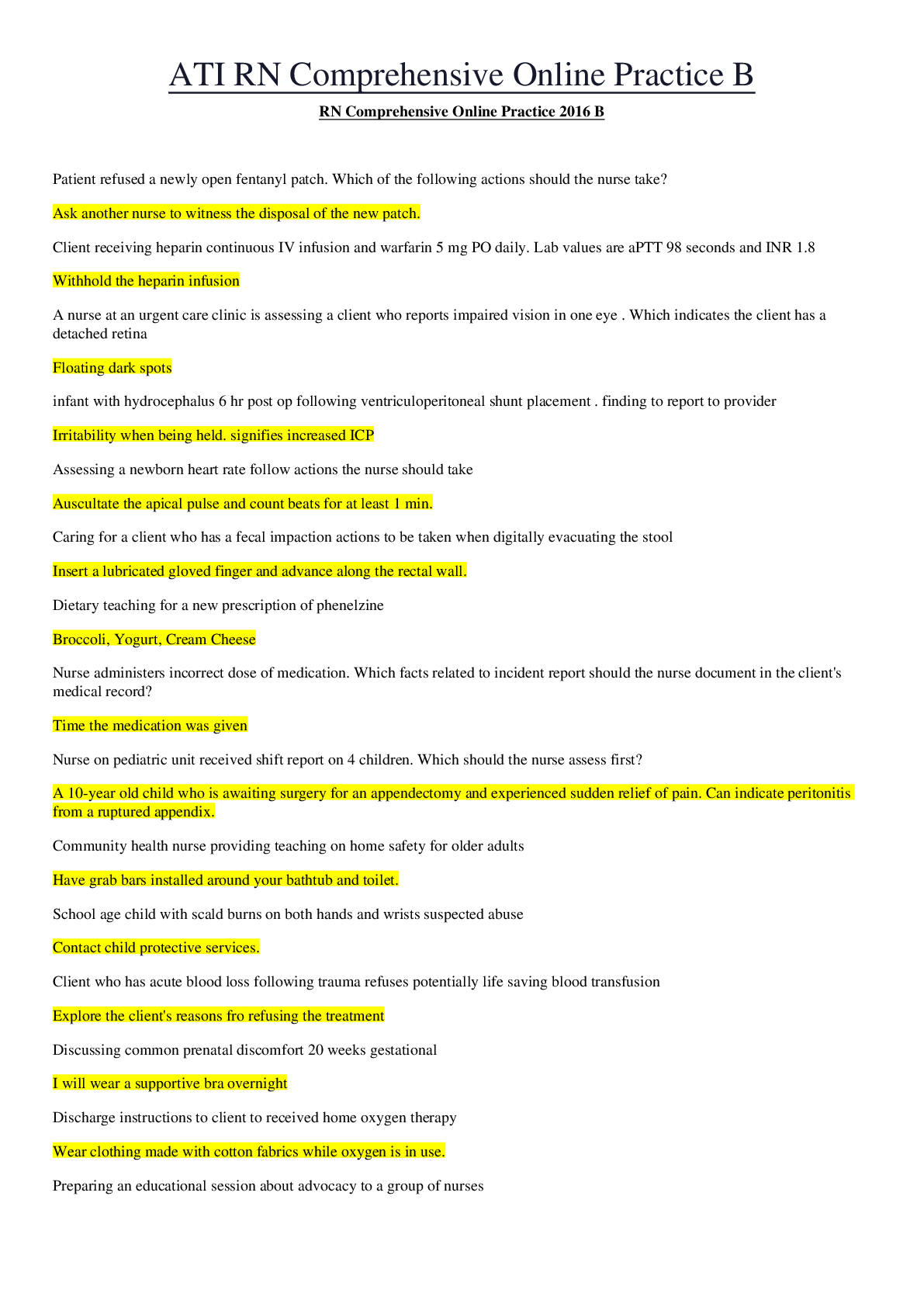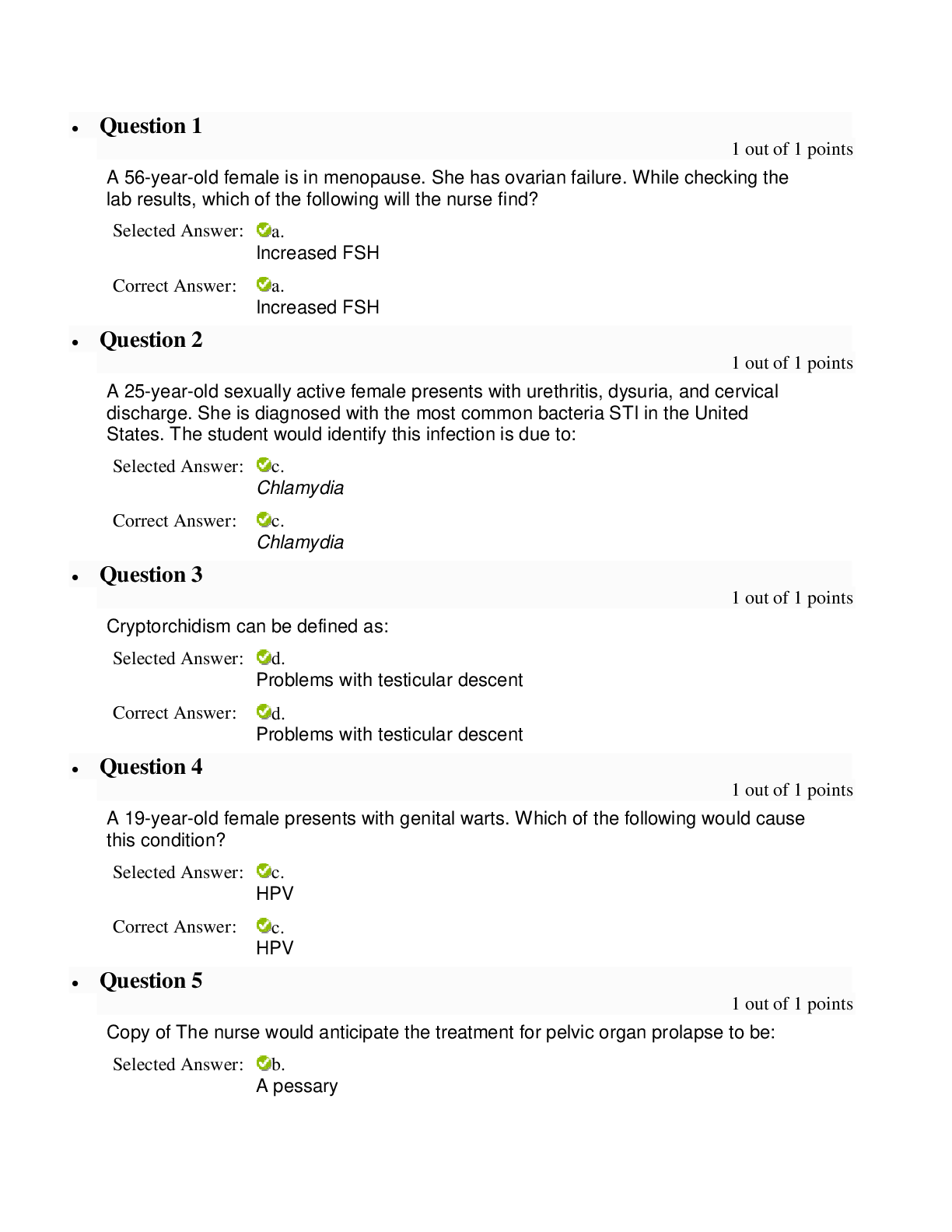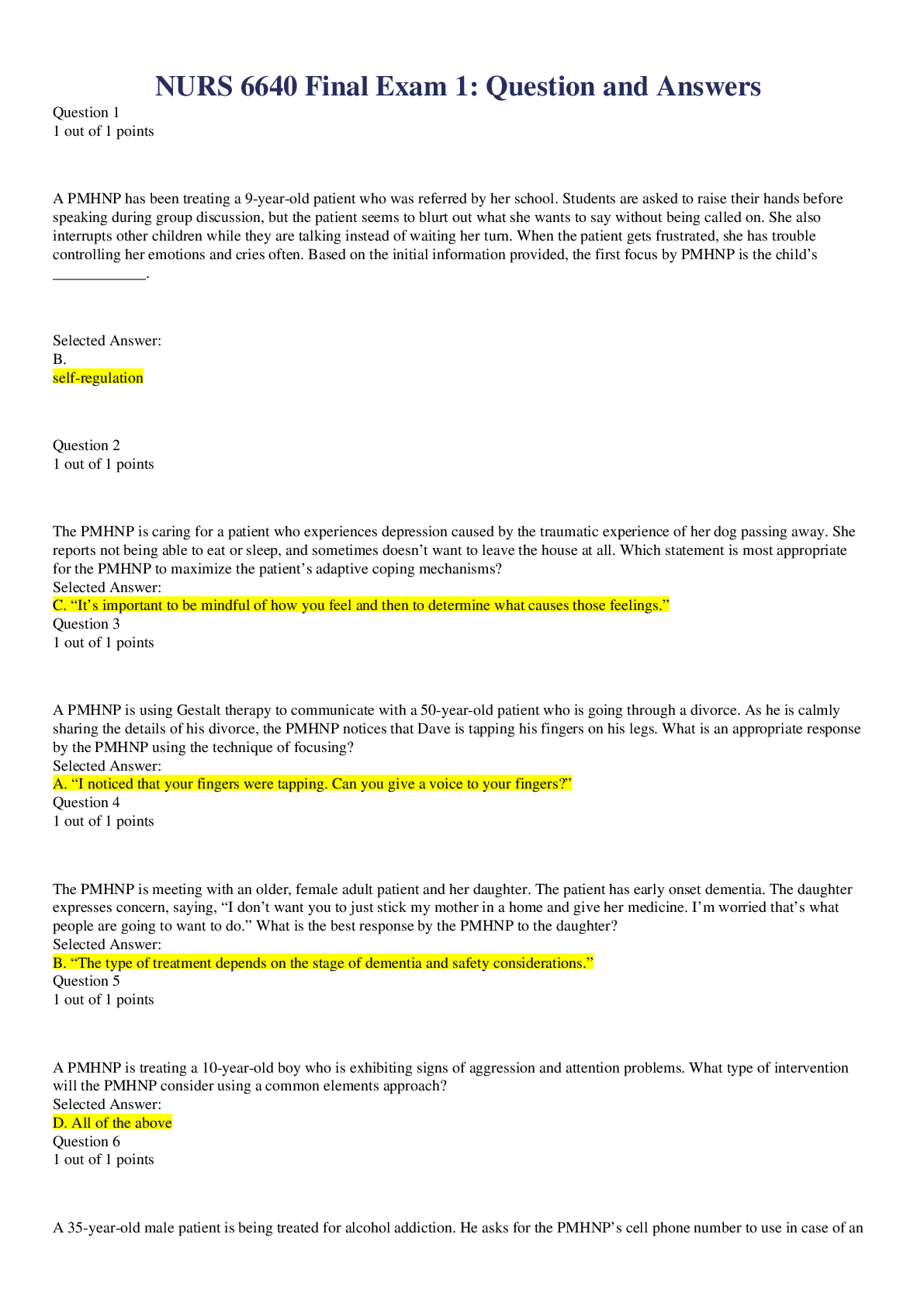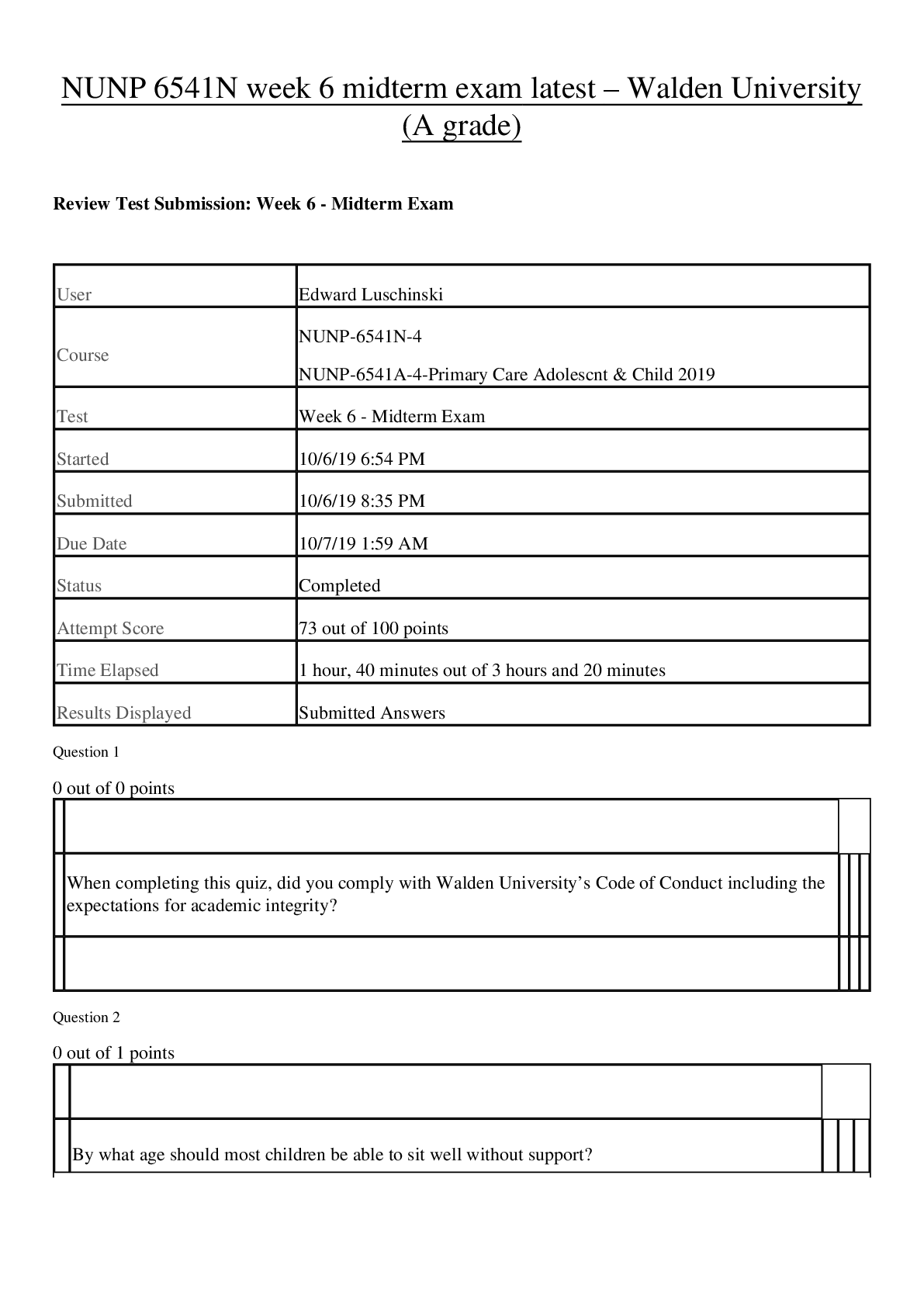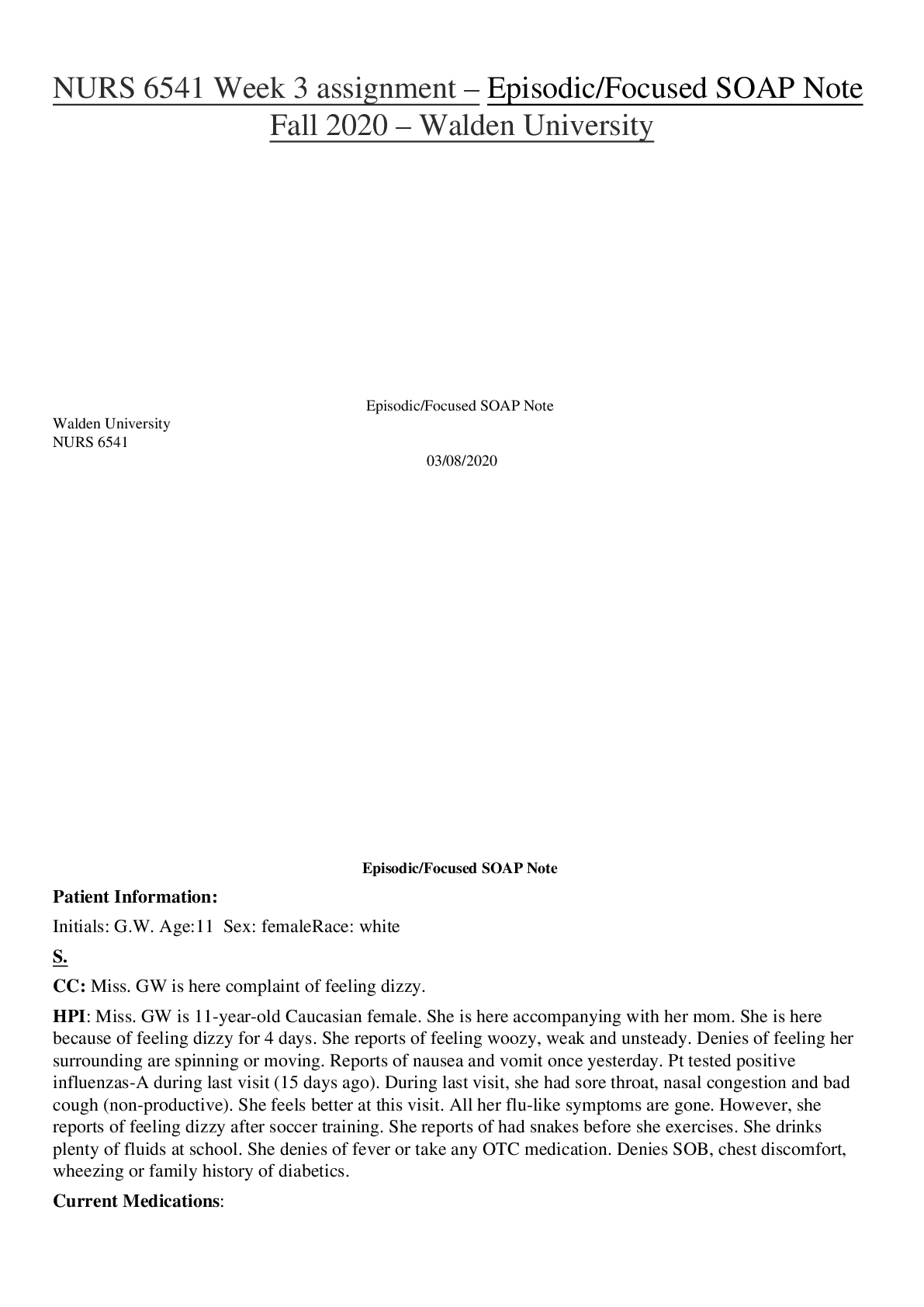NURS 6541 Midterm Exam Review 2020 (Week 1-6) – Walden University
Document Content and Description Below
NURS 6541 Midterm Exam Review 2020 (Week 1-6) – Walden University Week 1: Growth and Development • Safety with Car Seats – remain rear facing for as long as possible until they reach weight or... height of seat. https://www.aap.org/en-us/about-the-aap/aap-press-room/Pages/AAP-Updates-Recommendations-on-Car-Seats-for-Children.aspx • Vaccination Schedules and contraindications – o Hepatitis B – 3 dose series o Rotavirus – 2 dose series o Diphtheria, tetanus, & acellular pertussis (DTaP) – 5 dose series o Haemophilus influenzae type b (HIB) o Pneumococcal conjugate (PCV13) o Inactivated poliovirus (IPV) o Measles, mumps, rubella (MMR) o Varicella o Hepatitis A o Meningococcal o Tetanus, diphtheria, & acellular pertussis (Tdap) o Human papillomavirus (HPV) o Meningococcal B o Pneumococcal polysaccharide (PPSV23) • Child Abuse mandatory reporting – any reason to believe that there is abuse or neglect, you do not have to have burden of proof, • Failure to thrive causes o Childs environment (loss of emotional bond between parent and child, poverty, problems with child-caregiver relationship, diet, exposure to infections, parasites, or toxins, poor eating habits), abuse, neglect, genes such as Down syndrome, organ problems, hormone problems, damage to the brain or CNS may cause feeding difficulties, heart or lung problems, anemia, GI problems making it hard to absorb nutrients or cause a lack of digestive enzymes, long-term infections, metabolism problems, • Breastfed baby’s possible health problems o Lowers risk of asthma or allergies • Normal birth weights and growth – birth to 6 months growth ½ - 1 inch a month and gain 5-7 ounces a week. Double birth weight by 5 months • Normal reflexes in newborns o Rooting – goes away at 4 months - check stroked head turns to that side o Suck – when roof of mouth touch baby starts to suck begins 32 weeks and not fully developed until 36 weeks. o Moro – goes away at 3-4 months – startled o Step – goes away 2 months - appears to be taking steps o Tonic neck – goes away 5-7 months old. head relaxed and laying face up is moved to the side, the arm reaches away from body with had partially open o Grasp – goes away 5-6 months – stroke palm of hand and fingers grasp • Language development issues o Always check hearing • Fine motor skills o • Signs of puberty o Tanner stages ♣ 1 hair development, papilla above level of chest ♣ 2 sparse, long, pigmented, downy hair – hair seen along the labia and base of penis, small mounds and increased diameter of the areolae, enlargement of Scutum and testes and change in texture of scrotal skin ♣ 3 considerably darker, coarser, and curlier, hair is spread over pubes, breast and areolae cont to enlarge, length of penis some circumference, and increase growth in testes and scrotum ♣ 4 hair is adult like but decreased in total quantity, areolae and papillae elevate above breast, penis is larger in length and circumference, further development of glans penis, distinct darkening of scrotal skin ♣ 5 hair is in triangle and down thighs, mature breast, genitals are adult size o • Piaget developmental stages o Sensorimotor o Preoperational o Concrete o formal • Normal vital signs for various age groups o Infant (1-12mo)– RR 20-30 – HR 80-140 o Toddler (1-3 y.o) – RR 20-30 – HR 80-130 o Preschooler (3-5) – RR 20-30 – HR 80-120 o School Age (6-12) – RR 20-30 – HR 70-110 • Congenital infection with cytomegalovirus, complications of prematurity o Most common congenital viral infection o IUGR, prematurity, microcephaly, jaundice, petechiae, hepatosplenomegaly, periventricular calcifications, chorioretinitits, pneumonitis, hepatitis, and sensorineural hearing loss • Crawling (7-10 months), sitting (4-7 months without support 8 months), rolling over (tummy to back early as 4 months – 5-6 months back to front), walking milestones (9-12 months) Week 2: Infants, Toddlers, and Preschoolers • Normal premature infant growth • Protein calorie malnutrition • Small size differentials • Poor weight gain differentials • Well Child Visit standards for these age groups • Normal sequencing of development in a toddler • Treatment for teething • Early interventions services for speech • Sleep refusal • Bowel training issues • Breath holding • Bilingual children and expectations • Vaccination schedule • Normal sleep patterns • Correct order for introduction of food • Screening for TB • Normal breastfeeding schedules Week 3: School-Age Children and Adolescents • Drug Screening adolescents o Emergent clinical care for altered mental status, assessment of behavioral or mental health symptoms • Vaccination catch up schedule • Routine lab screenings • Anticipatory guidance for each age group • Bedwetting • Erickson’s stages of development o One – trust vs mistrust – Hope 0-1.5 o Autonomy vs shame and doubt – Will 1.5-3 o Three – initiative vs guilt – Purpose 3-5 o Four – industry vs inferiority – competency 5-12 o Five – identity vs role confusion – Fidelity 12-18 o Six – intimacy vs isolation – Love 18-40 o Seven – generativity vs stagnation – Care 40-65 o Eight – ego integrity vs despair – wisdom 65+ • Safety concerns • Bullying • Puberty • Adolescent substance abuse • Lab screenings in adolescents • Female peak height velocity Week 4: HEENT • Differential diagnoses for patients with HEENT disorders • Various treatment options for common HEENT disorders • Evaluate pattern recognition in patient diagnoses o Cobblestone appearance in throat and eyelids ♣ Polygonal cells bulge out from mucosal surface; can be caused by postnasal drip, laryngopharyngeal reflux (LPR) o Otitis media ♣ Otalgia with fever, N/V/D, hearing loss, difficulty sleeping ♣ Increase risk with smoking in house, bottle feeding, and daycare ♣ Bulging, erythematous TM, displacement of light reflex ♣ Oral analgesics, Amoxicillin, Cefdinir o Conjunctivitis, all types ♣ Viral, bacterial, and allergic ♣ Blurred vision, crust overnight, visual acuity should be unaffected, itching and watery discharge (allergic), foreign body sensation, photophobia, and discharge (viral), purulent (bacterial), severe eye pain (scleritis) o Corneal abrasion ♣ Foreign body sensation, tearing, redness, and discharge, vision is rarely affected ♣ Slit-lamp exam with fluorescein staining ♣ Remove foreign object, ATB ointment (bacitracin/polymyxin B or ciprofloxacin) and pupillary dilation o Keratitis ♣ Inflammation of the cornea o Hyphema o Nasal and eye foreign body o Allergic rhinitis ♣ Itching, sneezing, rhinorrhea, nasal congestion, conjunctivitis, caused by exposure to pollens or other allergens ♣ Antihistamines, decongestants, nasal corticosteroids o Hand, foot and mouth syndrome ♣ Caused by coxsackievirus A16, enterovirus 71, enteroviruses ♣ Can have sore throat or mouth pain, refuse to eat, fever, vesicles over buccal mucosa and tongue, palms of hands and soles of feet. Sometimes the butt and genitals o Strep pharyngitis ♣ Sore throat, fever, beefy red pharynx, purulent tonsillar exudate, cervical and submaxillary nodes o Glomerulonephritis ♣ Inflammation of the glomeruli blood vessels in the kidneys o Peritonsillar abscess ♣ Fever, throat pain, and trismus ♣ Ultrasongraphy and computed tomographic scanning to confirm diagnosis, needle aspiration is the gold standard with pcn, clinda, cephalosporins or metronidazole for ATB therapy o Epiglottitis ♣ Bacterial can rapidly progress ♣ Severe sore throat, dysphagia, high fever, drooling, and inspiratory stidor ♣ Protect the airway o Cervical adenitis ♣ Acute symptomatic enlargement of lymph nodes with spontaneous resolution over four to six weeks o Orbital cellulitis ♣ Caused by extension of adjacent sinuses, especially the ethmoid sinus ♣ Swelling and redness of the eyelid and surrounding soft tissues, conjunctival hyperemia and chemosisi, decreased ocular motility, pain with eye movements, decreased visual acutity, and proptosis ♣ ATB (clinda, vanc, doxy) o Visual acuity by ages ♣ Distance done by Snellen letters, numbers, picture test ♣ Ocular alignment done by unilateral cover test at 10 ft o Exotropia ♣ Form of strabismus where eyes deviate outward ♣ Transient intermittent seen in 4-6 week olds and spontaneously resolve. ♣ Constant is congenital o Esotropia ♣ Strabismus in which one or both eyes turns inward “cross eyed” o Strabismus ♣ Misalignment of the eyes that causes deviation from parallelism of normal gaze ♣ Risk factors – downs and crouzon, prenatal drug exposure, prematurity, low birth wt, congenital eye defects, and cerebral palsy ♣ Diagnosis with cover test ♣ Treatment – patching an corrective lenses, alignment by corrective lenses and surgical repair o Foreign body in ear o TMJ malocclusion ♣ Trauma, arthritis, bad bite where teeth do not fit together, muscles are not in right position when mouth is closed and it puts stress on the hard and soft tissues in the jaw o Bruxism ♣ Clenching or grinding of teeth o Excessive cerumen ♣ Causes hearing loss, irritation, pain, dizziness, and ringing o Epstein’s pearls ♣ Benign retention cyst resembling small pearls often seen in the palate ♣ Disappear within 1-2 weeks of birth o Exostosis ♣ Bone spur formation of new bone on the surface of bone ♣ Causes chronic pain, can be seen in the ribs, ankles, knees, shoulders, elbows and hips Week 5: Respiratory, Cardiovascular and Genetic Disorders o RSV ♣ RNA virus, pneumovirus, outbreaks occur mainly in winter and spring, most common cause of lower resp tract illness ♣ Begin URI, fever, dyspnea, cough, wheezing, crackles, apnea in infants <6 mo ♣ Supportive care, O2 and hydration, corticosteroids and bronchodilators, ribavirin o Pneumonia – bacterial, mycobacterial, viral, fungal, or parasitic o Bronchitis o Asthma o Croup – acute inflammation, caused by parainfluenza virus type 1 infection ♣ Barking couch and hoarseness, commonly at night, inspiratory stridor, ♣ Awaken at night with resp distress, tachypnea, and retrations ♣ Cool humidified air, single dose of long-acting corticosteroid, racemic epinephrine (5-10mg in 3 ml of saline q2h), dexamethasone 0.6mg/kg IM or PO o Bronchiolitis – acute viral infection of lower resp tract ♣ <24 mo peak incidence btwn 2mo-6mo ♣ Tachypnea, fever, retractions, and wheezy or hacking cough ♣ Premature infants’ recurrent apneic spells, typical symptoms over 24-48 hrs ♣ s/s of distress circumoral cyanosis, deepening retractions, and audible wheezing ♣ treatment supportive therapy, O2 needed, Iv hydration o Foreign body aspiration o Epiglottitis ♣ Inflammation and swelling of epiglottis ♣ Life threatening when it swells it can block the airway ♣ Hib – Haemophilus influenzae type b common cause o Tonsillectomy and adenoidectomy o Down syndrome - Trisomy 21 ♣ Intellectual disability, microcephaly, short stature, and characteristic facies, increased risk of obesity ♣ Gross motor and language delays, congenital heart disease, ventricular septal defects and atrioventricular canal, diabetes, celiac disease, hypothyroidism, Hirschsprung disease (delay of meconium of 48 hrs) o Edwards syndrome – Trisomy 18 ♣ Intellectual disability, small birth size, and various congenital anomalies, include severe microcephaly, heart defects, prominent occiput, low-set malformed ears, and characteristic pinched facial appearance. ♣ Prenatal history of feeble fetal activity, poly, small placenta, and single umbilical artery ♣ Clenched fist index finger overlaps 3rd and 4th fingers, redundant skinfolds over back f neck, clubfeet and rocker-bottom feet, congenital heart disease, patent ductus arteriosus, ventricular septal defects o Turner syndrome ♣ Girls are born with one of their two X partly or completely missing ♣ Coarctation of the aorta and bicuspid aortic valve, hypertension, development dysplasia of the hip ♣ Marked dorsal lymphedema of hands and feet, skin folds over back of neck, webbed neck and broad chest, wide spaced inverted nipples, short stature ♣ Management of comorbid conditions, possible surgical repair of cardiac abnormalities, growth hormone and estrogen o Fragile x syndrome – genetic abnormality of the X chromosome that causes intellectual disability and behavioral disorders. Abnormality of FMR1 gene unstable triplet repeat expansion; Fragile X syndrome is not a chromosome abnormality ♣ Physical, cognitive (autism, perseverative speech, poor eye contact, social anxiety), and behavioral abnormalities ♣ Large, protuberant ears, prominent chin and forehead, a high arched palate and postpubertal males macroorchidism, joints hyperextensible, mitral valve prolapse ♣ Early intervention, speech and language therapy and occupational therapy, stimulants, antidepressants, and antianxiety o XYY male ♣ Males have an extra Y chromosome ♣ Taller than average, acne, and an increased risk of learning problems, speech delay, low muscle tone (hypotonia), low-set ears, malar flattening (zygomatic flattening), o Klinefelter syndrome ♣ Male with an extra X chromosome ♣ Infertility and small testicles, weaker muscles, greater height, poor coordination, less body hair, breast growth, and less interest in sex ♣ Anxiety, impaired social skills, short attention span, and limited problem-solving skills, increase of DM2, blood clots, involuntary trembling, breast cancer, thinning and weakening of bones, systemic lupus, erythematosus, and RA o Cystic fibrosis ♣ Inherited disease with thick, sticky mucus buildup, mostly in resp and GI ♣ Sweat to be very salty, frequent sinusitis, bronchitis, pneumonia ♣ Intestines can’t fully absorb fats and proteins, diarrhea or bulky, foul smelling, greasy stools – poor wt gain and growth ♣ Treatment is preventing lung infections, loosening and removing mucus, preventing blockage in intestines, nutrition, hydration Week 6: Behavioral and Mental Health Issues o Child abuse o Adhd – symptoms can appear btwn 3-6 and continue ♣ Inattention – can’t keep on task, lacks persistence, has difficulty focusing and is disorganized ♣ Hyperactivity – moves constantly fidgets, taps, or talks ♣ Impulsivity – may have high potential for harm, desire immediate reward ♣ Treatments include stimulants to increase brain chemicals dopamine and norepinephrine they may decrease appetite, cause sleep problems, tics, personality changes, increase anxiety and irritability, HA and stomachaches – Amphetamines (dextroamphetamine, Adderal, and Vyvanse) – Methylphenidates (concerta, metadata, Ritalin, focalin) ♣ Other meds include Strattera, Wellbutrin, guanfacine, clonidine o Autism ♣ Repetitive patterns of behavior and difficulties with social communication and interaction ♣ Rarely make eye contact, fail to engage in typical babbling ♣ Diagnosed with no babbling or pointing by age 1, no single words by age 16 months or 2-word phrases by age 2, no response to name, loss of language or social skills acquired, poor eye contact, excessive lining up of toys or objects, no smiling or social responsiveness ♣ Behavioral/educational interventions early - o Dyslexia – learning disorder involving problems in reading, mathematics, spelling, written expression or handwriting ♣ Delayed language production, speech articulation difficulties, remembering names of letters, numbers, and colors, difficulties with word problems despite normal math computation skills ♣ Diagnosed with reading evaluation, speech, language, and auditory evals, psych eval ♣ Educational interventions, direct and indirect instruction in word recognition and component skills o Fetal alcohol syndrome – alcohol exposure in utero increases risk for Spontaneous AB, decrease birth weight, ♣ Small IUGR at birth, microcephaly, microphthalmia, short palpebral fissures, epicanthal folds, small or flat midface, flat elongated philtrum, thin upper lip, small chin, abnormal palmer creases, cardiac defects, joint contractures ♣ After birth cognitive deficits ♣ Treatments supportive care o Depression ♣ Antidepressants plus psychotherapy (>8 fluoxetine) • SSRI first line [Show More]
Last updated: 2 years ago
Preview 1 out of 12 pages
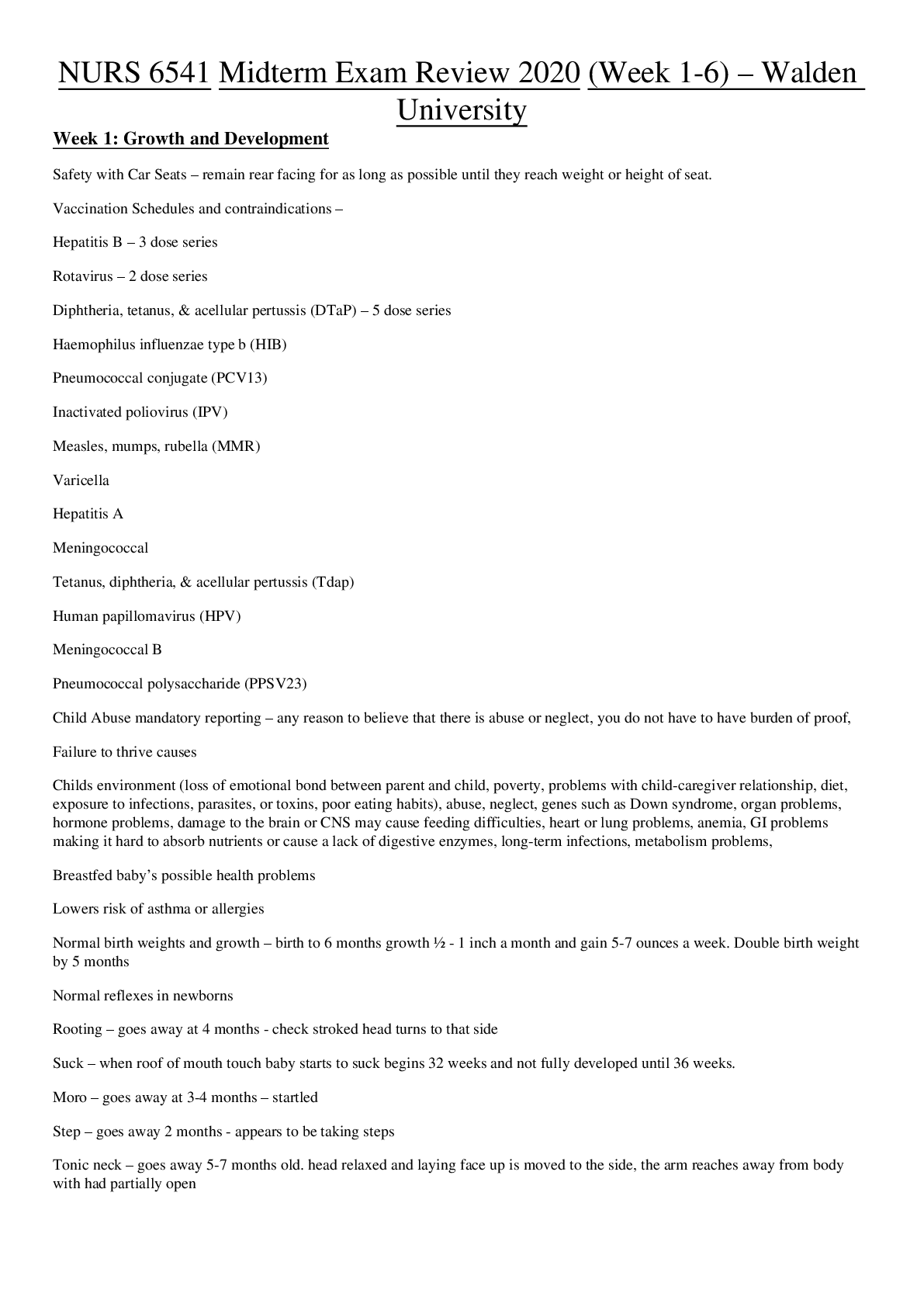
Buy this document to get the full access instantly
Instant Download Access after purchase
Buy NowInstant download
We Accept:

Reviews( 0 )
$12.50
Can't find what you want? Try our AI powered Search
Document information
Connected school, study & course
About the document
Uploaded On
May 18, 2020
Number of pages
12
Written in
Additional information
This document has been written for:
Uploaded
May 18, 2020
Downloads
0
Views
139





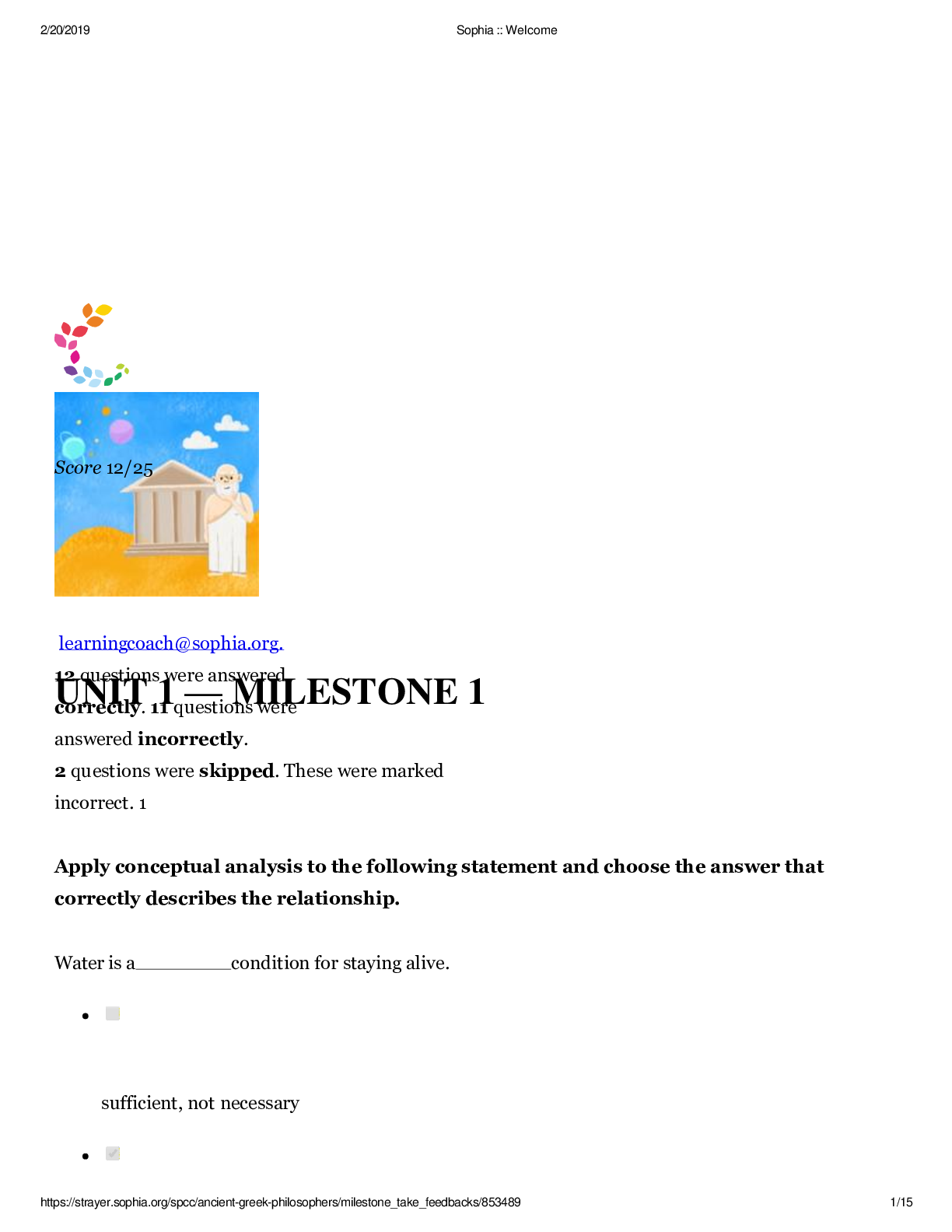


 – University of the People.png)
